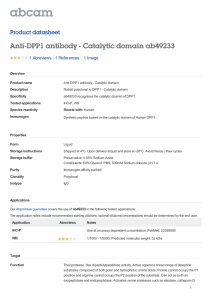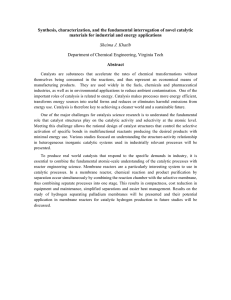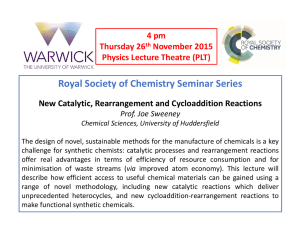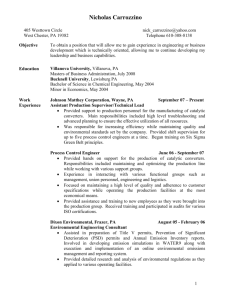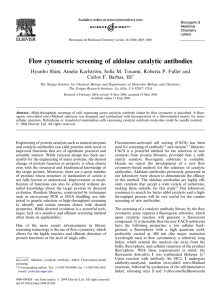lNstrtuts @ rHs ScruppsRnsaaRcH
advertisement
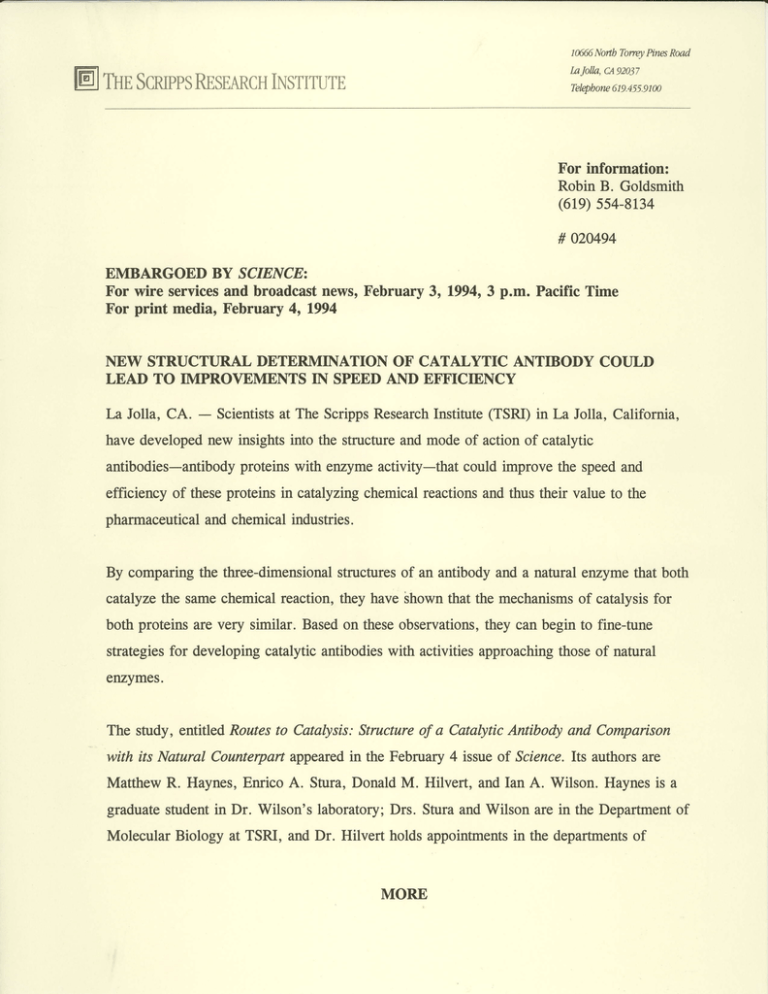
1Kt66Nottb TorrcyPinesRoad IiJolk, cA92o37 lNstrtuts @ rHsScruppsRnsaaRcH Tel@bore619.455.9100 For information: Robin B. Goldsmith (619)5s4-8134 # 020494 EMBARGOED BY SCIENCEz For wire servicesand broadcastnews, February 3, 1994,3 p.m. Pacific Time X'or print media, February 4, t994 NEW STRUCTIJRAL DETERMINATION OF' CATALYTIC ANTIBODY COI,JLD LEAD TO IMPROVEMENTS IN SPEED AND BFFICIENCY La Jolla, CA. - Scientistsat The ScrippsResearchInstitute(TSRI) in La Jolla, California, have developednew insights into the structureand mode of action of catalytic antibodies-antibodyproteinswith enzymeactivity-that could improvethe speedand efficiency of theseproteins in catalyzingchemicalreactionsand thus their value to the pharmaceuticaland chemicalindustries. By comparing the three-dimensionalstructuresof an antibody and a natural enzymethat both catalyzethe samechemicalreaction,they havebhownthat the mechanismsof catalysisfor both proteinsare very similar. Basedon theseobservations,they can begin to fine-tune strategiesfor developingcatalyticantibodieswith activitiesapproachingthoseof natural erzymes. The study, entitled Routesto Catalysis:Structureof a Catalytic Antibody and Comparison with its Natural Counterpartappearedin the February4 issueof Science.Its authorsare Matthew R. Haynes,Enrico A. Stura,DonaldM. Hilvert, and Ian A. Wilson. Haynesis a graduatestudentin Dr. Wilson's laboratory;Drs. Sturaand Wilson are in the Departmentof in the departmentsof Molecular Biology at TSRI, and Dr. Hilvert holds appointments MORB Page2 - STRUCTTJREAND FTJNCTIONOF CATALYTIC ANTIBODMS The feasibility of developingantibodieswith catalyticpropertieswas pioneeredat TSRI in the late 1980s.Combiningtechniquesand principlesof chemistry,molecularbiology, immunology,and geneticengineering,this technologyholds the promiseof developing catalystsfor many thousandsof chemicalreactions. The technologicalimplicationsof this vastpool of potentialantibodycatalystsare enormous. For example,many of the chemicalreactionsusedtodayto producepharmaceuticals and other valuablecompoundsare difficult and expensiveto run and producelow yields of product. Indeed,somereactionschemistswould like to carry out on an industrialscaleare simply not feasible.With the right antibodycatalysts,however,thesesamereactionscould be madeto run swiftly, with greatprecision,and in high yield-much in the sameway that biological reactionsoccur in the presenceof enzymes. Catalyticantibodiesare preparedby raisingantibodiesin animalsagainstsyntheticcompounds called transitionstateanalogues.As bondsare madeor brokenin chemicalreactions,there is a point at which the componentsof the reactionexist in an intermediateconfiguration where the reactioncould go either way. This molecularconfiguration,calledthe transitionstateof the reaction,has a fleeting existenceand cannotbe isolated.However, chemistscan deduce what the transition stateof a particular reactionmust look like and createcompoundswith very similar shapes-transitionstateanalogues. Enzymescatalyzeor acceleratechemicalreactionsby binding thesetransitionstatesand stabilizingthem, therebyincreasingthe likelihoodthat the reactionwill occur. Similarly, antibodiesthat can bind to transitionstateanaloguescan alsobind the correspondingtransition statesthemselves.Thus, they too catalyzechemicalreactions. MORE Page3 - STRUCTIJRE AND FTINCTION OF CATALYTIC ANTIBODIES Unfortunately,the majority of the catalyticantibodiesgeneratedto datepossessbut a small fraction of the chemicalactivity of naturalerzymes.It is a seriousproblem; in order to be useful in biotechnologicaland industrialapplications,catalyticantibodieswill needto havefar greateractivity. To approachthis issue,the TSRI investigatorsmadea direct comparisonof the threedimensionalstructuresof a catalyticantibodyand an erzyme that carry out the samechemical reaction.By so doing, they hopedto gain insight into the precisenatureof catalysisby these different proteins,and the particulararchitecturalfeaturesof the catalyticsurfacesthat acceleratethe chemicalreaction. The systemthey choseto studyinvolvesa chemicalreactionin plantsand bacteriathat is integralto the synthesisof certainamino acids.Specifically,it is the conversionof the compoundchorismateto prephenate,an event catalyzedby the erzyme chorismatemutase. For the past severalyears,Dr. Hilvert and his colleaguesat TSRI havecarriedout detailed studiesof a numberof catalyticantibodieselicitedagainsta transitionstateanalogueof the chorismate-prephenate reaction.Using the techniqueof x-ray crystallography,Haynesand Drs. Stura and Wilson determinedthe completethree-dimensional structureof one of these catalyticantibodieswith the transitionstateanalogueboundto the catalyticsite. For comparison,they usedthe three-dimensional structureof the enzymechorismatemutase, also bound to the sametransitionstateanalogue,which recentlyhad beenpublishedby investigatorsat Harvard University. The chorismatecatalyticantibodyhas aboutone ten thousandththe catalytic activity of the natural erzyme. MORB Page4 -- STRUCTLJREAND FLJNCTIONOF CATALYTIC ANTIBODIES A study of the two structures,antibody and erzyme, showedthat both appearto catalyzethe reactionin essentiallythe sameway. This finding refutesthe suggestionby somescientists that although enzymesand catalytic antibodiesboth may be able to carry out the same chemicalreaction,the precisemechanisms of catalysismay not be the same. Also of major importancewas the identification of those structuralfeaturesof the enzymethat most likely accountfor the much greateractivity of the enzymeas comparedto tlre antibody. This information, they suggest,can now be usedto dramaticallyimprove the catalytic efficiency of antibodiesby suchstrategiesas improvingthe designof transitionstate analoguesand altering the structureof antibodyproteinsby site-directedmutagenesis techniques. ###

